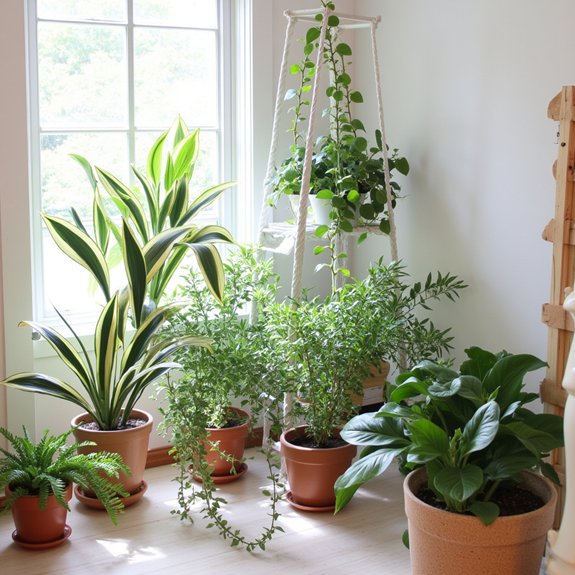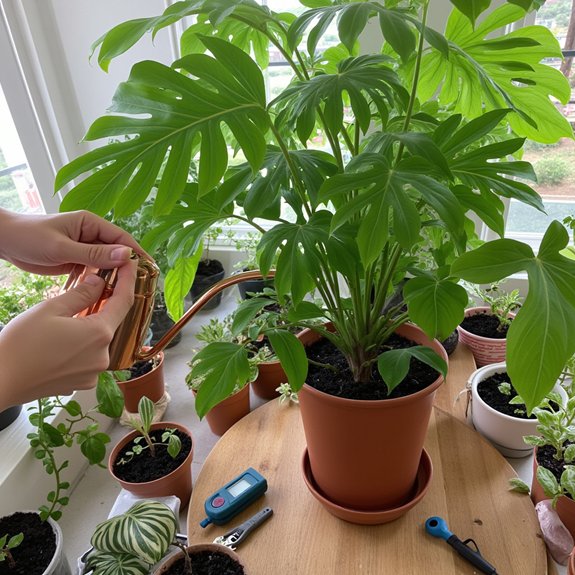Homeowners discover that strategically placed leafy houseplants can dramatically alter their living spaces within weeks, creating healthier environments while adding natural beauty. Snake plants, pothos, and rubber trees require minimal attention yet deliver maximum impact, thriving in low to moderate light conditions that suit most indoor spaces. These green companions actively filter toxins from the air, removing formaldehyde and benzene while releasing fresh oxygen. However, selecting the right plants for specific rooms requires understanding light patterns, humidity levels, and maintenance schedules that many enthusiasts overlook.
Contents
- 1 Low-Maintenance Plants Perfect for Beginners
- 2 Air-Purifying Varieties That Clean Your Home
- 3 Propagation Techniques for Expanding Your Collection
- 4 Light Requirements and Placement Strategies
- 5 Watering and Care Guidelines for Healthy Growth
- 6 Colorful Foliage Options for Visual Impact
- 7 Flowering Houseplants That Bloom Indoors
- 8 Creating the Ideal Environment for Plant Success
Low-Maintenance Plants Perfect for Beginners

Several houseplants thrive with minimal attention, making them ideal choices for new plant parents who want greenery without the stress. Snake plants top the list of easy care plants, tolerating low light and requiring water only when soil dries completely. ZZ plants offer similar resilience with glossy, drought-tolerant leaves that forgive neglect.
Pothos and spider plants represent excellent beginner friendly options, growing rapidly in various light conditions while tolerating occasional watering mistakes. These trailing varieties add visual interest without demanding constant care, making them perfect starter plants for building gardening confidence.
Air-Purifying Varieties That Clean Your Home
Nature’s air filters work around the clock, removing toxins while adding beauty to indoor spaces. Snake plants excel at filtering formaldehyde and benzene, making them ideal bedroom companions since they release oxygen at night. Their striking upright leaves require minimal care, thriving in low light conditions.
ZZ plants offer impressive air purifying benefits while tolerating neglect beautifully. These glossy-leafed champions remove xylene and toluene from indoor air. Spider plants rank among the most effective plant species for eliminating carbon monoxide and other harmful chemicals, plus they’re incredibly easy to propagate from their natural “babies.”
Propagation Techniques for Expanding Your Collection

Building a thriving indoor garden doesn’t require constant trips to the nursery when you master simple propagation methods. Most houseplants reproduce easily through leaf cuttings or stem sections, turning one plant into many. Start by selecting healthy leaves from established plants, ensuring clean cuts with disinfected tools. Propagation mixes provide ideal drainage while maintaining necessary moisture for root development.
Different propagation methods suit various species. Snake plants and peperomias thrive with leaf cuttings, while pothos prefers stem sections. Growth timeframes vary greatly, with some plants rooting within weeks, others requiring months. Moisture conservation remains essential throughout the process, determining success rates.
Light Requirements and Placement Strategies
Understanding your home’s natural light patterns transforms plant placement from guesswork into strategic success. Light intensity varies dramatically throughout spaces, requiring careful observation of brightness levels at different times.
North-facing windows provide gentle, consistent illumination perfect for snake plants and pothos. East windows offer morning brightness that suits African violets and peperomias beautifully. South-facing areas deliver intense light ideal for succulents like jade plants and kalanchoe.
Placement angles matter greatly for best growth. Position light-sensitive plants three to five feet from bright windows, while low-light varieties thrive in corners or hallways with minimal natural illumination.
Watering and Care Guidelines for Healthy Growth

While light creates the foundation for plant health, proper watering techniques determine whether houseplants thrive or struggle in their new environment. Most houseplants prefer soil that dries completely between waterings, particularly drought-tolerant varieties like snake plants and ZZ plants. Water quality greatly impacts plant health; filtered or distilled water prevents mineral buildup that can damage roots. Check soil moisture by inserting your finger two inches deep—if it’s dry, it’s time to water. Humidity levels should range between 40-60% for ideal growth. Many plants benefit from weekly watering schedules, though succulents require less frequent attention.
Colorful Foliage Options for Visual Impact
Three standout houseplants transform any room into a vibrant display through their naturally colorful foliage, eliminating the need for constant flower maintenance. Begonias offer exceptional texture variety with their patterned leaves featuring silver, red, and deep green combinations. These shade-loving plants thrive indoors while providing year-round visual interest.
Kalanchoe presents thick, succulent leaves in rich green tones, often developing reddish edges when exposed to bright light. The waxy texture creates stunning contrast against other houseplants.
Alocasia delivers dramatic impact with its arrow-shaped leaves showcasing vibrant colors ranging from deep purple undersides to metallic green surfaces, making each plant a living artwork.
Flowering Houseplants That Bloom Indoors
Several popular houseplants reward indoor gardeners with stunning blooms throughout the year, bringing both fragrance and color directly into living spaces. African violets produce charming purple flowers under bright, indirect light, maintaining compact growth perfect for windowsills. Kalanchoe offers vibrant flower clusters in red, pink, yellow, and orange from November through spring.
Christmas cactus creates spectacular indoor blooms during winter months, displaying bright pink and red flowers from November to February. These flowering varieties require consistent care, proper lighting, and regular fertilization to maintain their blooming cycles successfully indoors.
Creating the Ideal Environment for Plant Success
Most houseplants thrive when gardeners understand their specific light, water, and humidity requirements rather than applying generic care routines. Snake plants tolerate low light and drought, while African violets need bright, indirect sunlight to bloom properly. Soil composition matters greatly—succulents like jade plants require well-draining mixes, whereas tropical plants prefer moisture-retaining potting soil. Humidity levels should match each plant’s origin; ZZ plants handle dry air, but Alocasia needs higher moisture. Check soil dryness by inserting your finger two inches deep. Group humidity-loving plants together, or place them near humidifiers for ideal growing conditions.
